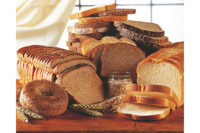As consumers’ interest in healthy eating continues to grow, so does their search for flavorful, prepared foods—including baked goods and snacks—with fewer calories and less salt, processed sugar and artificial ingredients. Products made with nutritious ingredients that have been around forever, such as fruit, nuts and chocolate, are more likely to find their way into the shopping carts of these concerned consumers. And such product ingredients will continue to do so, as food producers, bakers and snack makers work together to educate Americans about the nutritional benefits of these enduring ingredients and develop new products that incorporate them.
Take blueberries, for instance. Many consumers are just beginning to discover that fresh blueberries contain naturally occurring antioxidants that can help protect the human body from the damaging effects of free radicals and chronic diseases associated with aging. The blue superfruits are low in calories, carbohydrates and cholesterol; they’re virtually fat-free; and they’re a good source of fiber, vitamin C and manganese.
Bakers and snack producers considering the use of blueberries in their products will find these fruits also to be super in terms of formats and availability. “The multiplicity of formats and year-round availability of highbush cultivated blueberries makes it possible to incorporate them in a wide variety of applications,” says Thomas Payne, industry consultant for the U. S. Highbush Blueberry Council, San Mateo, Calif. For instance, fresh, whole berries are easy additions to mini pastries and cupcakes. Dehydrated blueberries can be used in cookies and bagels and high-tech blueberry powders work well in rice cakes and bar cookies.
Payne also cites some “more interesting” ways in which blueberries currently are being used: In ice cream cones; pancake mix; salsas; sauces; candy; and a blueberry pill that has the same amount of anthocyanin as 90 g. of blueberries.
Retailers and consumers can expect to see even more blueberry products in the coming year, says Payne, as “food product developers are taking advantage of the quasi-mythical power of blueberries-as-imprimatur and using blueberries to rev up interest in offerings from beauty-from-within foods to health-halo desserts, confections and snacks.”
According to Payne, beauty-from-within products comprise a category of ingestibles also called cosmeceuticals or nutricosmetics. Nutricosmetics are entering the marketplace through a variety of nutraceuticals, beverages and functional foods that purport to beautify the body from within. They generally contain antioxidants and fruit extracts, sport a superfruit halo and promote natural approaches to nourishing skin and general wellness.
“People trust blueberries,” Payne says. “They trust what they grew up with. They remember their parents and grandparents eating and loving blueberries. They serve blueberries to their children. Blueberries have always been considered good, wholesome and delicious—they are comfort food with benefits. You can’t get any more super than that.”
Like blueberries,California raisins offer consumers and bakers a variety of benefits. Health-conscious people who enjoy snacking on, or baking or cooking with, raisins appreciate that these fruits are all-natural, fat- and cholesterol-free and high in antioxidants and potassium. They also contain inulin, a naturally occurring polysaccharide produced by some plants, and polyphenol, an antioxidant.
Raisins are also an extremely versatile ingredient, suitable for use in a host of baked goods, trail mixes, cereals, sauces, puddings and more.
Some bakers, meanwhile, are also using raisins and raisin paste to replace processed sugars in their baked goods. “In some cases, bakers are replacing 50% of processed sugar with raisins and raisin products and, in some cases, 100% of the processed sugar is being replaced,” says Larry Blagg, senior vice president of marketing for the California Raisin Marketing Board, Fresno, Calif. “As the government continues to focus on obesity and Type 2 diabetes as the top medical issues in the U.S., such reformulations of bakery products into more healthy finished products can only be beneficial to all.”
Going nuts
Most people agree that fruit is part of a healthy diet. When it comes to nuts, however, some still erroneously think they’re high in unhealthy fats and calories.
California walnuts, for instance, contain numerous beneficial nutrients. According to the Folsom, Calif.-based California Walnut Board, they’re a source of good polyunsaturated fat (PUFA), which includes essential alpha-linolenic acid (ALA), a plant-based, Omega 3 fatty acid. A serving of walnuts contains 18 g. of total fat, 13 g. of PUFA and 2.5 g. of ALA.
Walnuts also contain antioxidants (selenium, melatonin, gamma-tocopherol and others), several polyphenols, protein, fiber, magnesium and phosphorus. No wonder research studies suggest that walnuts can be great additions to heart-healthy, diabetic and weight-management diets.
Like blueberries and raisins, walnuts can be consumed as is or used in a variety of applications, including baked goods (bread, pastries, cookies and cakes) and as a salad topping or sauce ingredient. In fact, the California Walnut Board hires food scientist and consultant Rachel Zemser each year to develop new formulations to display at the Institute of Food Technologists’ (IFT) Annual Meeting and Expo in Las Vegas.
“The goal [of the recipes] is to inspire manufacturers to look at our ideas with the hopes of maybe doing them,” says Zemser, who has been working with the board for the past three years. Her 2011 formulations included a gluten-free walnut cake, chocolate-dipped and cocoa-dusted walnuts and a fruit and walnut cream brioche pastry.
“When creating recipes, I try to look at things that are popular—food that’s trendy,” Zemser explains, adding that Spanish food and Mediterranean and Turkish seasonings are popular now and have influenced her creations for the 2012 IFT expo in June.
Walnuts’ ellipsoidal cousin, the California almond, also offers consumers a healthy, flavorful snack and bakers and snack producers a nutritious ingredient for use in better-for-you products. According to the Almond Board of California, Modesto, Calif., California almonds contain vitamin E, magnesium, manganese, copper, phosphorous, riboflavin and fiber. In addition, a 1-oz. serving of the cholesterol-free nuts has 13 g. of unsaturated fats and just 1 g. of saturated fat.
No wonder global consumer demand for products containing almonds continues to grow. “The health message both in the U.S. and globally has been a strong driver,” says Bill Morecraft, general manager of Blue Diamond Growers’ Global Ingredients Division, which focuses on the bakery, confection, energy bar and cereal categories. The Sacramento, Calif.-based company, a member-owned grower cooperative, also has a consumer snack division that offers a variety of almond products, including flavored almonds, crackers made with almonds and an almond beverage.
“With bakery, one of the things that we’re trying to do with existing product lines is communicate the health benefits of almonds and line up with [manufacturers’ and consumers’] concerns for the health benefits of food,” explains Morecraft. “With baked goods, manufacturers focus on how they can bring healthy foods [to market] by including healthy ingredients. We have a very strong story with almonds. Almonds are an excellent source of vitamin E. They’re also gluten-free ingredients, so there are a lot of applications that work well with almonds. They really fit well with the idea of adding a healthy aspect to baked goods.”
Morecraft adds that Blue Diamond Growers has also been working recently with different cereal companies to develop flavor extensions of sliced and slivered almonds with coatings and flavors to augment their products.
The power of chocolate
Like nuts, chocolate is often vilified (but still enjoyed) by many people. Studies throughout the years have turned up both health benefits and liabilities associated with eating chocolate.
Recent research, however, indicates that dark chocolate may help lower high blood pressure, as well as containing antioxidants that may help ward off heart disease and other medical issues.
“It is well-known that dark chocolate contains flavanol antioxidants,” says Matt Crumpton, vice president of marketing, Puratos Corp. Inc., Cherry Hill, N.J. “So Puratos is proud to introduce Oxanti, a new great-tasting dark chocolate from its Belcolade [brand].”
According to Crumpton, Oxanti contains flavanol antioxidants that offer long-lasting antioxidant power, while still delivering the taste and texture of real Belgian chocolate, thanks to a patent-pending conching process that helps retain the maximum amount of the cocoa bean’s natural antioxidant. Made from single-origin cocoa beans from Ecuador (65% cocoa content), Oxanti is designed to help customers meet the demand for healthier, better-quality food, while delivering a taste that consumers will love. Applications include cakes, muffins, cereal and snack bars, breakfast cereals and pralines.
Cryst-o-fil, another recent release from Puratos, is an easy-to-use base for creating chocolate fillings. The product is based on patent-pending pre-crystallized technology, includes a minimum 50% Belgian chocolate, and is designed to give producers the flexibility to create a variety of chocolate fillings with a longer shelf life from one base.
“Saving time and money are two key necessities for both the industry and their consumers,” says Crumpton. “The flexibility of Cryst-o-fil lets producers choose ingredients that will help lower the cost of the filling, which, in turn, can lower the cost of the final product for the consumer. For instance, adding fondant or water to Cryst-o-fil can significantly lower the recipe cost, and stable aeration can more than double the volume and further reduce overall cost.”
Lititz, Pa.-based Cargill Cocoa & Chocolate also recently launched several new chocolaty ingredients for bakers and snack producers: Wilbur Pristine, a white confectionery coating suitable for wedding applications or making colored coatings with oil-based colorings; the Gerkens range of Dutch Dark premium cocoa powders, which enable commercial bakers and snack producers to develop chocolaty-tasting products using less cocoa powder; and Peter’s 62% semi-sweet chocolate, which can be used to enrobe or drizzle products, or melted for use in formulations.
According to product development supervisor Josh Rahn, Cargill Cocoa & Chocolate is also doing some work under the Wilbur brand with enhanced protein levels in coatings to give customers the tools they need to make nutritive claims. “Nutritive claims are important because consumers want to be able to indulge, while also doing something good for their health,” he says. “Protein is gaining interest, especially related to healthier snacking and weight management. It is often paired with chocolate-generating opportunities for new product development.
“Dark chocolate has received a lot of positive press about potential health benefits associated with consumption,” he adds. “Consumers are becoming more discriminatory in how they consume calories, so it’s a bonus if they can indulge in dark chocolate, which contains antioxidants.”
No doubt, fruit and nuts producers and other chocolate companies feel the same way about the products they offer today’s health-conscious consumers.
The Stand-Ins |
|
For some bakers and snack manufacturers, customized food inclusions and particulates are the ingredients of choice for giving a product a distinctive taste, look or texture, as well as enhancing it with vitamins, Omega 3 and other nutritional properties. And for those interested in inclusions and particulates that emulate fruit or nuts, QualiTech Corp. says it’s a great go-to source. According to senior food scientist Kristy Ruhland, the Chaska, Minn.-based company has created a variety of fruit inclusions for customers, including raspberry, blueberry, tart cherry and more recently, exotic flavors like mango, guava and acai. These products can be made with all-natural ingredients, require no refrigeration, have a long shelf life and are ideal for applications in which real fruit won’t work. Ruhland recalls the creation of its raspberry inclusion: “We had a major retail chain come to us, wanting to develop a raspberry cookie. The problem with using real raspberries is that when you cook with them, the fruit turns gray or dark brown, which isn’t visually appealing. So the company asked us to develop an inclusion or particulate that would help it deliver an awesome raspberry flavor, but eliminate any negative attributes. We created a raspberry inclusion with real raspberry fruit powder that’s consistent in color, look, feel and aroma and, when cooked, looks like real pieces of raspberry or raspberry jam.” QualiTech also offers inclusions and particulates that emulate popular nuts, including peanuts, almonds and pecans. Helping bakers and snack manufacturers reduce their ingredient costs, they also enable the products to be allergen- and nut-free. |









